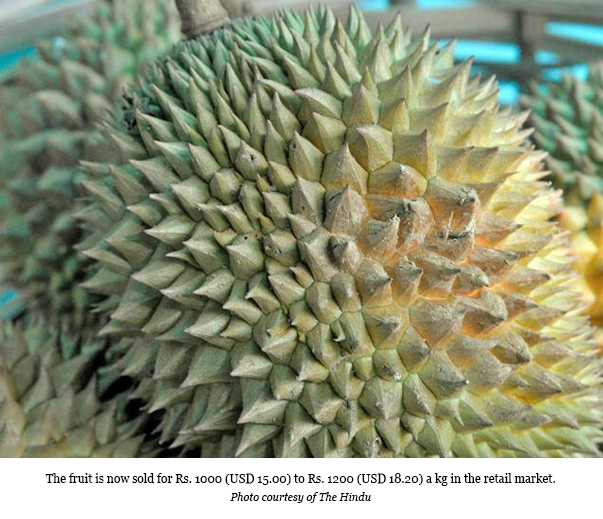by Deepa H. Ramakrishnan, The Hindu
Did you know a fruit has a six-month waiting period?
People, who like the taste of durian and believe that it has some medicinal qualities, call up the Government Horticultural Farm in Burliar in The Nilgiris and leave their contact numbers so that they can pick up the fruit when it is harvested.

The Burliar farm has 33 trees that are very old and the three-month-long season for the fruit is just coming to an end now.
The Burliar season is July- August-September and the Kallar season, February-March-April.
“Despite its ‘strong, sweet smell,’ people believe that the fruit, native of Indonesia, can treat infertility and buy it. People from all over the State come to the farm,” says an official of the Horticultural Department.
With the fruit gaining popularity, many farmers have started picking up saplings from the Burliar and the Kallar Horticulture Farms that have a total of 60 trees.
“Though durian is believed to grow in sub-tropical and tropical climates, recently a farmer reported that it can grow in the plains too,” an official at the farm says.
“A fruit can weigh anywhere between 750 gm to 3.75 kg. Since each fruit has only about two to three seeds, there is great demand for saplings. Earlier, only farmers from Kerala used to buy the saplings. However, there seems to be more awareness now among farmers in Tamil Nadu . Those having coconut groves buy the saplings,” the official says. Ecologist Sultan Ahmed Ismail, who has participated in durian harvest festivals in Malaysia, says it is a tourist attraction in that country. “The king of fruits, as it is called, has a heavenly taste. Though on the outside it looks thorny and resembles jackfruit, it is soft and succulent on the inside. It is rich in minerals and vitamins,” he says.
Syed Sulaiman, a wholesale seller of durian in Ooty, says that the fruit is now sold for Rs. 1000 (USD 15.00) to Rs. 1200 (USD 18.20) a kg in the retail market. “We do not pluck the fruits at Burliar since the trees are very tall. Instead, we pick them up from the ground as they are just right to eat. The fruits can be kept for about four days,” he adds.
Source: The Hindu
